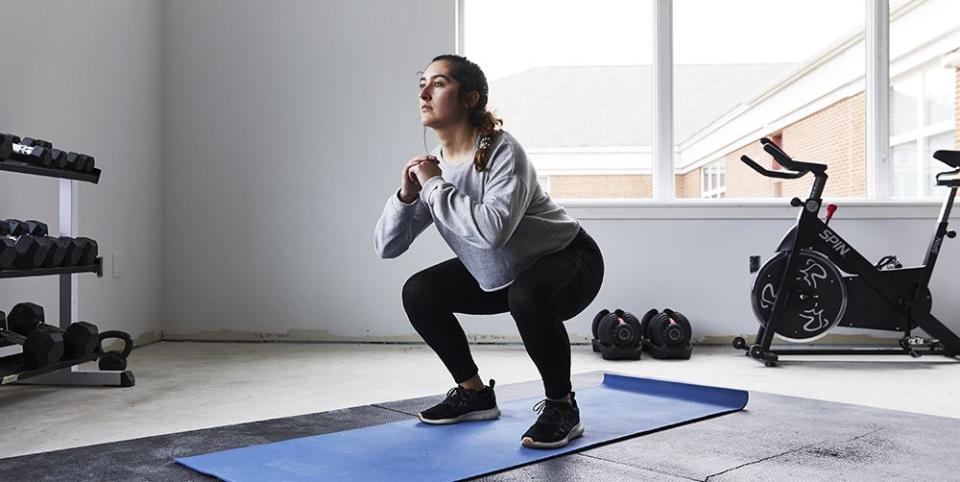Try this cardio workout from home

High-intensity interval training, or HIIT for short, was named one of the top fitness trends in the world in 2020, based on an annual survey by the American College of Sports Medicine. Why? Because it works, and it works fast. Whether you’re coming straight off the sofa, training for a marathon or even if you race for a living, HIIT sessions are good for your health and performance.
What exactly is HIIT?
HIIT is composed of short, hard bouts of cardio exercise – anywhere from 10 seconds to five minutes in length – broken up by brief recovery periods.
How hard you go depends on the interval length, but the key is to go as hard as you can for the duration of the effort. So if you’re doing Tabata (20 seconds of effort, followed by 10 seconds of recovery), you’re going full throttle for 20 seconds. If you’re doing longer, three- to five-minute intervals, you’re working in your VO2-max zone, or about 95 per cent of your max heart rate (a 9 on a scale of 1 to 10) for the duration of the interval.
How much recovery you take between intervals depends on your goals. Short intervals are usually paired with equally short or even shorter recovery periods, so your body can adapt to repeated maximal efforts. And because your heart rate stays elevated during the recovery periods, your aerobic energy system gets a training benefit, as well. In other cases, such as longer high-intensity sprints, you want each effort to be done at max, so you need to let your body fully recover for four or five minutes between bouts.
What are the benefits of HIIT?
A study in the November 2018 issue of the American Journal of Physiology – Regulatory, Integrative and Comparative Physiology found that just two minutes of sprint interval training (in this case, four 30-second, max-effort sprints followed by four and a half minutes of recovery for a total of 20 minutes) improved mitochondrial function – when your cells can change fuel to energy quickly, a benchmark for good health and exercise performance – just as well as 30 minutes of moderate exercise in a group of active men and women. In other words, busting out two minutes of really hard running can give you the same fitness benefits as 30 minutes at a steady, moderate pace.
HIIT workout at home
Try this eight-move, equipment-free workout from home. Do each exercise for 45 seconds, with a 15-second break between moves and a two-minute break between sets. Do two sets in total for an all-body workout in less than 20 minutes.
Mountain climbers
In a press-up position, bring your right knee up to your right elbow, then return it to the starting position. Repeat the movement on your other leg. Continue alternating legs throughout.
Body-weight squats
Stand with your feet shoulder-width apart, toes turned slightly outwards. Hinging at the hips, bend your knees to lower into a squat position until your thighs are parallel with the floor. Press into your midfoot to straighten your legs to stand, with your hips and torso rising in unison.
Press-ups
Get on all fours, placing your hands slightly wider than your shoulders. Straighten your arms and legs, lower your body until your chest touches the floor. Push back up to starting position. If that’s too difficult, put your knees on the floor throughout the movement.
High knees
Standing with feet hip-width apart, run up and down on the spot, lifting your knees as high as you can. Stay tall and land on the balls of your feet.
Plank
Similar to press-up position, but with weight on your forearms rather than your hands. Push into the ground with your toes and squeeze your glutes. Ensure your back and bottom aren’t popping up or caving in and that you are making a straight line from heels to head. Hold this position.
Burpees
Stand with your feet shoulder-width apart. Hinge at the hips and bend your knees to squat as deeply as you can and place your hands on the floor. Jump your feet back to come into a high plank position (top of a press-up). With your core engaged, bend your elbows to lower your chest to the floor, like a press-up. Press back up as you jump your feet back into a deep squat and jump (or stand) back up, landing on the balls of your feet.
Sit-ups
Lie on your back. Bend your legs and place your feet firmly on the ground to stabilise your lower body. Cross your hands to the opposite shoulders over your chest or place them behind your ears, without pulling on your neck. Curl your upper body all the way up toward your knees. Exhale as you lift. Slowly, lower yourself down, returning to your starting point. Inhale as you lower.
Split lunge jumps
With your feet shoulder-width apart, core engaged and shoulders back, step back with your left leg and lower. Keep the weight on the ball of your back foot, and your front foot flat. Jump up to switch legs in midair – left leg forward, right leg back; land with both knees at 90 degrees. Keep switching legs throughout, using your arms to help you jump explosively and keeping your chest lifted.
You Might Also Like

 Yahoo Sport
Yahoo Sport 





































